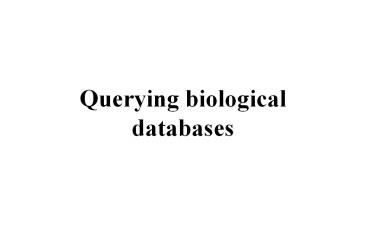Querying biological databases - PowerPoint PPT Presentation
1 / 13
Title:
Querying biological databases
Description:
EB-eye searches all EBI databases. NCBI Entrez ... Using Boolean operators: gene AND regulation or cell AND (repression OR activation) ... – PowerPoint PPT presentation
Number of Views:88
Avg rating:3.0/5.0
Title: Querying biological databases
1
Querying biological databases
2
How to query databases
- Query languages e.g. SQL
- Can query with keyword or phrase
- Boolean queries
- Regular expressions
- Basic database querying is usually done through
web interface - Text or sequence-based searches
- Can use Boolean queries and regular expressions
3
Keywords and phrases
- Most searches are case insensitive
- Keywords are single words searched
- Phrases groups of words
- E.g. tyrosine protein kinase returns anything
with either of the words tyrosine , protein
or kinase (keywords) - tyrosine protein kinase returns anything with
the complete phrase only
4
Boolean operators (George Boole)
- Operators e.g. (AND), (OR), ! (NOT), e.g.
- protein kinase ! tyrosine
- tyrosine protein kinase
- More complex (tyrosine OR kinase) AND (NOT
serine) - Operators dont work in , e.g. tyrosine and
kinase - Wildcards and ? E.g. cellase finds all words
starting with cell and ending in ase - Attributes are used to be more specific about
where to find the keyword
5
Resources for searching databases
- Each database usually has own web interface
allowing simple queries - EBI or NBN Sequence Retrieval System (SRS)
- EB-eye searches all EBI databases
- NCBI Entrez
- E.g. EnsMart allows querying of Ensembl database
6
UniProt website (http//www.uniprot.org/)
7
Sequence Retrieval System
- http//srs.ebi.ac.uk
- Integrates over 150 different databases
- A database can be searched and results linked to
other databases in SRS - Searches can be simple or complex
- Results can be viewed in default formats or
user-defined views - Users can save their results and launch software
packages (gt100 applications) to analyse results
8
SRS at EBI -library page
9
Advantages of SRS
- Choice of databases to search
- Linking between databases
- Launching applications from results
- Saving results in different formats
- Simple or very complex queries possible
- Can upload own database
10
NCBI Resources
11
Querying Medline
- Simple query, e.g. for author jones sm
- Using search fields (attributes) jones AU
- More complex query jones AU 1999 DP
- Using Boolean operators gene AND regulation or
cell AND (repression OR activation) - If no operators specified, assumes AND
12
Types of search fields
- Title Words TI MeSH Terms MH
- Title/Abstract Words TIAB Language LA
- Text Words TW Journal Title TA
- Substance Name NM Issue IP
- Subset SB Filter FILTER
- Secondary Source ID SI Entrez Date EDAT
- Subheadings SH EC/RN Number RN
- Publication Type PT Author Name AU
- Publication Date DP All Fields ALL
- Personal Name as Subject PS Affiliation AD
- Page Number PG Unique Identifiers UID
- Title Words TI MeSH Major Topic MAJR
- MeSH Date MHDA
13
Tutorial http//cbio.uct.ac.za/training/courses
/short-courses/nbn-databases-course/querying-datab
ases-tutorial-1/































